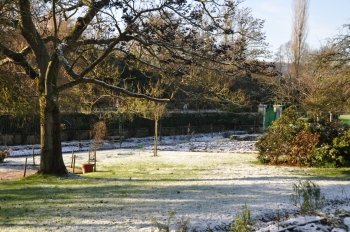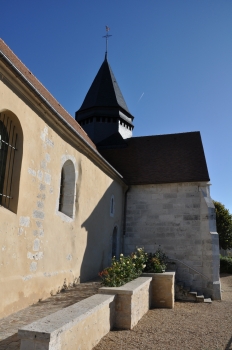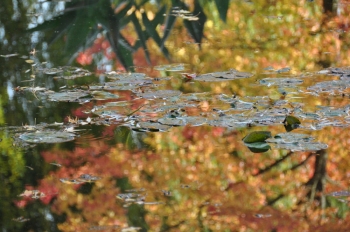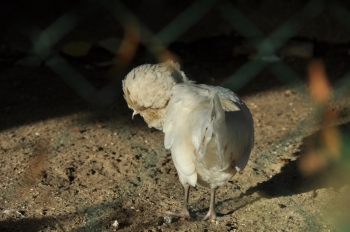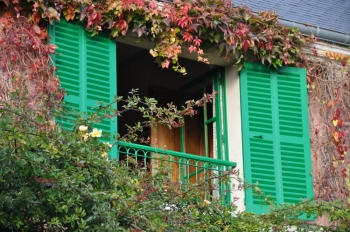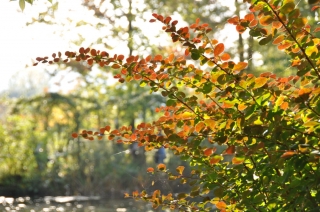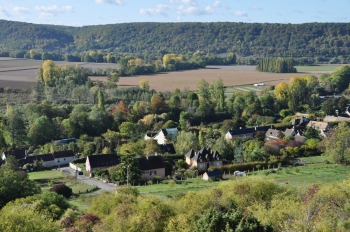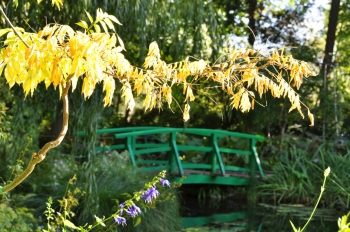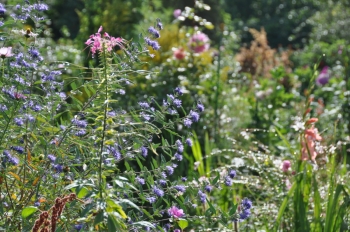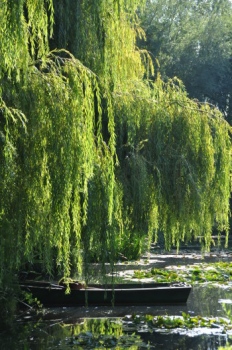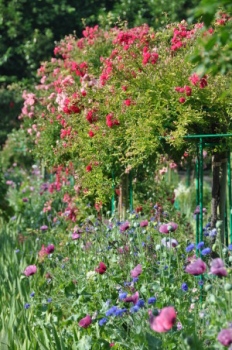December 31, 2010
My German friend Veronika Stark painted this view of Monet’s garden under the snow.
It has been white for almost two weeks lately, but now the snow has gone.
I wish you all a wonderful celebration of New year’s Eve and a peaceful 2011. Hope to see you at Giverny!
Posted in Monet's House No Comments »
December 14, 2010
 Monet
Monet
Thanks to Google maps, centered on Monet’s bust at Giverny, this is how Monet’s gardens look from a bird’s view. (it may take a while to load)
The pattern of flower beds looks very straight.
The green roof on the left is the greenhouse.
The big dark roof along rue Claude Monet is Monet’s home.
On the right you can see the big roof windows of his third studio.
If you drag the picture to the left you will visit the village of Giverny. The Museum of Impressionism has terrace roofs.
If you drag the picture to the bottom you will see the poplar grove that was chopped down last year.
Have a nice virtual tour of Giverny!
Posted in Giverny 2 Comments »
December 12, 2010
It snowed for the second time of the season at Giverny last Wednesday, what is rather unusual so early, at the end of Autumn.
But the gardeners are still working in the garden! They plant the bulbs and pansies for next Spring. Thousands of them. And when the weather is really too cold and snowy, they stay inside and maintain the gardening tools.
Do you recognize on the picture the ladies corner, this round shaped little square under the paulownia, where Mrs Monet and her daughters used to sit down in the afternoon?
Posted in Giverny, Monet's flower garden No Comments »
December 10, 2010
The church of Giverny looks beautiful! The works are almost finished by now, they have lasted three years.
Everything was scanned, repaired or replaced, from the roaster on the top of the spire to the murals inside of the choir. The result is stunning.
The church of Giverny deserves this attention. The oldest part dates back to the 11th Century.
Claude Monet and his family celebrated their religious events in this sanctuary.
Monet is buried in the nearby cemetery.
Posted in Giverny 1 Comment »
November 29, 2010
The beauty of late season at Giverny relies on the reflections on Monet’s pond.
The surrounding trees turn red, orange, yellow and dip their image into the water.
Their warm colors split in dots of changing shapes form a stunning contrast with the cold blue and perfectly defined leaves of the remaining water lilies.
This picture was taken one month ago. Now the leaves have been blown away, and Fondation Claude Monet is closed until next 1st April.
Posted in Giverny, Water-Garden No Comments »
November 13, 2010
A few steps away from his home at Giverny, Claude Monet had a chicken yard full of hens, and Fondation Claude Monet still keeps a few chickens in this corner of the garden.
Just like Monet, they don’t choose every year the same breed. In 2010, visitors enjoyed looking at the funny Padua chickens, absolutely stylish with their fluffy feathers on the head.
Monet loved to have fresh eggs at hand, and the family must have eaten many every day, according to the storage available: in the pantry of Monet’s house, two boxes could contain 116 eggs!
But hens were not a sign of wealth for a family belonging to the middle upper class, this is why they were hidden in a corner of the garden under a big fig tree. However, their presence was revealed by crowing of the roaster.
Turkeys, on the contrary, were considered decorative fowl and were proudly shown in the turkey yard next to the kitchen.
Nowadays, the turkey yard displays turkeys and chickens together. The roasters of both yards like to have sort of a dialog, exchanging their cock-a-doodle-do. The big roaster in the turkey yard has a deep voice, the Padua roaster in the chicken yard a high pitched one, and when they talk together, they are absolutely irresistible.
I kindly dedicate this post to Cynthia Brian, the “Chicken Lady”, co-author of “Chicken Soup for the Gardener Soul”.
Posted in Monet's House, Impressionism Museum 3 Comments »
November 8, 2010
In his water garden at Giverny, Claude Monet planted tall trees like weeping willows, ash trees, chestnut trees, poplars, copper beeches…
They were underplanted by shrubs that offered their interesting foliages, flowers, berries, and scents: roses, tree peonies, azaleas, rhododendrons, viburnums, Japanese maples, ferns…
These shrubs were underplanted by flowers, for example flag irises, to provide a touch of vibrant color.
Thus, Monet created a little world that resembled a clearance in the woods.
He liked to feel blended with nature. Staring at the reflections of the sky into the pond, he could loose any notion of himself and merge into the waterscape.
Posted in Water-Garden No Comments »
November 1, 2010
Today was the last day of the season at Giverny.
At 6.00pm, the flags at the entrance gate were taken in for the last time of the year and the last visitor left.
The shutters of Monet’s home will stay closed tomorrow, while the gardeners will start their rush before frost.
They have to store fragile plants in the greenhouses, and pull out all the flowers to clean the beds and start thinking of next spring. Fall and winter are a busy time for the gardeners!
Posted in Giverny, Monet's House No Comments »
October 27, 2010
Autumn has just touched Monet’s garden with its magic.
The foliage change their greens or dark reds to bright tones. The weeping willows get gold, the poplars and the wisterias yellow, the needles of the taxodium rost, the liquidambars turn red and orange…
The huge copper beech is not copper anymore, but a light brown, and all the leaves of the irises, thalias, hostas and other water side plants say goodbye to the season in a mixture of green, brown and yellow shades.
All these colors reflect into the pond in a stunning way. Each hour is different, from vaporous foggy mornings to bright sunny afternoons, and brings its own light on to the pond for the enjoyment of the last visitors of the season.
Posted in Water-Garden No Comments »
October 23, 2010
Giverny lies west of Paris, 80 km away from the city, in the Seine valley.
The river flows at the bottom of the hill on the background of the picture. It has carved deeply the tender chalk of the plateau, creating steep hills.
The bottom of the valley is floodable, this is why the village was built at the foot of the hill. It stretches over three kilometers along a single street, now named after Claude Monet.
Only a small portion of Giverny can be seen on the photo. (click to enlarge)
Right in the middle, you can see the big studio of Monet, recognizable thanks to the window panes on the roof. On its right, the long pink house with a slated roof is Monet’s home. And on the right of the house, the next building was Monet’s second studio (see the windows on the roof there too).
Behind these three buildings one can notice the garden. The trees on the pond side blend into the nature around, hardly noticeable by their more vibrant colors. And behind Monet’s gardens, fields show that there are good alluvial grounds here.
Nesting in its natural surroundings, Giverny is a rural village in the countryside, living on a slower pace than the big city of Paris. Being a nice day out is one of the assets of an excursion to the home of Claude Monet.
Posted in Giverny, Monet's House No Comments »
October 7, 2010
Two curved bridges face one another on both ends of Monet’s pond at Giverny.
The big one is covered with wisterias, whereas the small one doesn’t have any.
But a neighbouring wisteria can give the illusion that it is covering the little bridge too!
Its golden color brightens all the greens around.
Posted in Giverny, Water-Garden No Comments »
September 13, 2010
Summer is coming to an end, offering a large display of flowers in Claude Monet’s gardens at Giverny.
The flower beds that looked organised in early season are now full of overgrown plants, sunflowers, dahlias, cosmos…
Under the clematis, smaller borders catch the morning light dancing on the freshly watered gauras.
Posted in Giverny, Claude Monet, Monet's flower garden No Comments »
August 18, 2010
Weeping willows were among Claude Monet’s favorite trees for many reasons, one of them being the translucent quality of their leaves.
On the side of his water lily pond at Giverny, Monet planted several willows.
Two of them still survive, although some branches start to become hollow.
But young willows planted thirty years ago, like the one on the picture, are now mature, as big as Monet could have seen them.
Weeping willows fascinate because of their vertical twigs that beautifully reflect into the pond.
Visitors will also see two other kinds of willows, the tortuous ones, very decorative, and the basket willows.
Generally pruned drastically to force the willow to produce new twigs every year, that will be cut to weave baskets, these willows like the river borders and are part of the traditional landscape of Normandy.
In Monet’s gardens, however, one of them was allowed to grow, and its branches pointed to the sky like a V make it resemble a person with the arms up. A very happy willow!
Posted in Giverny, Water-Garden 2 Comments »
August 1, 2010
Water lilies are summer flowers.
They like a warm water and a lot of sunshine.
In Monet’s garden at Giverny, the Nympheas that grace the pond are at their peak.
Their crowns of pale petals reflect in the changing colors of the surface, creating harmonies that inspire the many painters visiting the gardens.
Posted in Water-Garden, Flower No Comments »
July 4, 2010
In Monet’s garden at Giverny, the month of June is a feast of colors.
In the flower garden turned into a rose garden for a month, weeping roses as big as trees fall from their metallic structure in the shape of a mushroom.
Their pink harmonizes with the blues and purples of the flowers below. A soft match that will last a few days only, before other eye cathing colors appear somewhere else.
Posted in Giverny, Monet's flower garden No Comments »
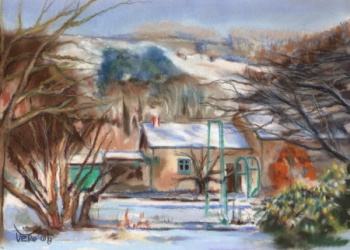
 Monet
Monet